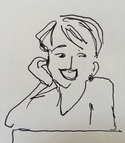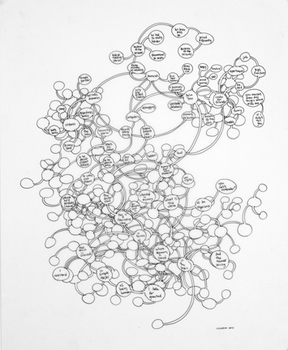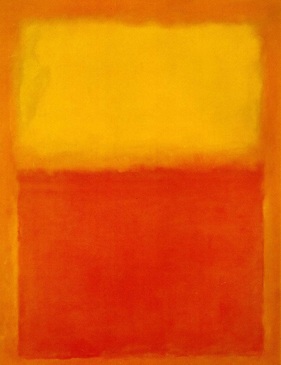Thresholds of significance: some art and science collaboration
 Deborah Aschheim
Deborah Aschheim I learned from Deborah that when it comes to neurology, what is going on behind closed medical doors continues to fascinate non medical people, a la Oliver Sacks. Deborah is a visual artist and used the UCSF Memory and Aging Center, its patients and its machines (EEG, fMRI, eye tracker) as her subject matter.
In the case of Deborah, I would be more interested to use neurosciences as a tool to analyze the way her brain functions when she manipulates visual versus verbal concepts, both being predominant in the work she showed us. For example, in the drawing below, she represents the mind of a patient with dementia. There is an explicit dialogue between the visual qualities in her work (ex: complex 3D structure floating in space, high contrasted black and white values) and the verbal and conceptual component (words in the bubbles, concept of empty bubbles referring to language loss in this patient).
In the case of Deborah, I would be more interested to use neurosciences as a tool to analyze the way her brain functions when she manipulates visual versus verbal concepts, both being predominant in the work she showed us. For example, in the drawing below, she represents the mind of a patient with dementia. There is an explicit dialogue between the visual qualities in her work (ex: complex 3D structure floating in space, high contrasted black and white values) and the verbal and conceptual component (words in the bubbles, concept of empty bubbles referring to language loss in this patient).
Verbal concepts, writing, reading, or drawing are processed through distinct and complex pathways in the brain, more or less overlapping with the visual pathways. What would Deborah's brain activation map look like had we analyzed it while she was developing the visual versus the verbal conceptual parts of her work? Could we connect the dots visually as in the connectome project, or using a visually enabled mapping of the artistic brain of some sort? Or watch it happening live as with the latest visualization technologies at the cellular level?
Unfortunately, both artistic processes are so intertwined in her work that it would be hard to design an experiment to separate one from another - not talking about the whole thing happening in the tunnel of an MRI machine.
However, wouldn't it be fascinating -and controversial!- to compare how the brain is activated by predominantly conceptual versus predominantly visual art in general? Try out and compare your experience when you focus on each of the two pictures below, one after the other: do you think it triggered the same network of reactions in your brain?
Unfortunately, both artistic processes are so intertwined in her work that it would be hard to design an experiment to separate one from another - not talking about the whole thing happening in the tunnel of an MRI machine.
However, wouldn't it be fascinating -and controversial!- to compare how the brain is activated by predominantly conceptual versus predominantly visual art in general? Try out and compare your experience when you focus on each of the two pictures below, one after the other: do you think it triggered the same network of reactions in your brain?
This raises the eternal question of the feasibility of deconstructing the artistic process to a point that is accessible to scientific analysis.
This is part of a series of posts on the 11th International Conference on Neuroesthetics (September 2014).



 RSS Feed
RSS Feed